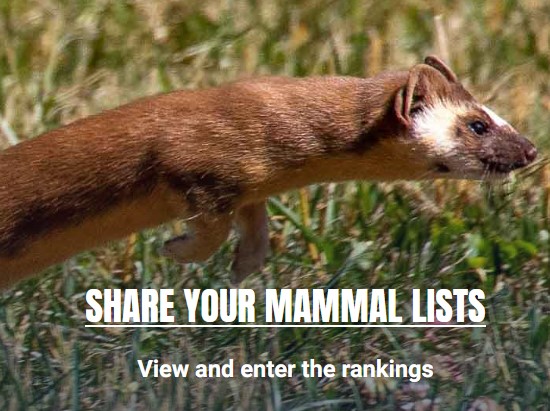
Updated mammal taxonomy and new league tables for cetaceans, carnivores and ungulates
I’ve updated the global mammal taxonomy list to incorporate the latest updates to the Mammal Diversity Database. Plus – after popular request – we have added new league tables for anyone who loves spreadsheets as much as I do. There are now separate league tables for all mammals, primates, cats, cetaceans, carnivores and ungulates. So please sign up and flex those life lists in the spirit of friendly competition for conservation.
https://www.mammalwatching.com/resources/the-mammal-list-rankings/
Longtime listers will remember my checklist started life 10 years ago based on the IUCN’s Red List data and has gradually shifted to follow the American Society of Mammalogists’ Mammal Diversity Database (MDD). The MDD is regularly updated has become the gold standard of mammal taxonomy. So this time I am following it completely for my global list. The two lists differ only in their coverage of extinct species, which the MDD include and I have not.
But to keep everyone on their toes there are a few plot twists for the other league table lists.
Domestic Species
Like the MDD I include domestic species in my global list. I personally count these when they are living wild (feral).
I followed a different route for the lists covering the league tables for particular mammalian orders and families. For these lists I have removed domestic species.
Domestic (feral) Cat is no longer on the cat list (by popular demand);
Domestic Ferret (Mustela furo) is not on the carnivore list, although I have kept Canis familiaris as Dingos are more wild than domestic in my view; and
Domestic Cattle, Sheep and Pigs and among the species that are not on the ungulate list.
Primates
The primate league table list still follows the IUCN’s Primate Specialist Group taxonomy. It is a little different to the MDD list, though it is also kept up-to-date. Some of the world’s top primate listers follow this taxonomy and so I continue to use it here for the primate league table.
Might these differences between the global and other lists be confusing? Yes. Are they illogical? Definitely. But I’m hoping for options that work for everyone. In any case the global and primate league are different leagues and so different rules can apply. Something that isn’t uncommon in some of the world’s other great sporting competitions!
None of these lists is perfect but then neither is taxonomy. I know not everyone will agree and might continue to follow their own favourite taxonomies. Yes I might be overthinking this.
Changes Since the Last Update in January 2024
The global list spreadsheet details changes since the previous version. The Mammal Diversity site also provides information on their previous lists.
Here are a few of the more notable changes that may affect your lists.
Bornean Striped Palm Civet (Arctogalidia stigmatica) is now lumped with the Small-toothed Palm Civet (A. trivirgata).
Killer Whales have now been split into three species with the addition of Transient (Bigg’s) Killer Whales (which you may have seen off of Monterey for example) and the Resident Killer Whales off of British Columbia.
Eastern Pacific Long-beaked Common Dolphin has returned as a species (also sometimes seen off of Monterey).
Neotropical River Otter has been split. Annoying because I haven’t seen the one that occurs in Central America.
Fringe-lipped Bats (Trachops sp.) have been split three ways. Not annoying because I have seen them all.
Changes to the primates on the global list (which now follows the MDD’s primate taxonomy) are more numerous especially among the capuchins, many of which the MDD have lumped. There are, as explained above, fewer changes to the list that we use for the primate league table.
After all these lumps and splits my list went down by just one species.
The fabulous and free Scythebill Software is already using these updates. I love this software and it makes handling these changes pretty easy – putting most of them through automatically when I updated taxonomies. I don’t know how it did that.. but it does. So in the long run it is worth investing the time in putting your list into Scythebill.
Please let me know what you think and what mistakes you notice.
Jon
Post author
1 Comment
Leave a Reply
You must be logged in to post a comment.


Michael Johnson
In Australia, feral cats are so different to and evolved from domestic cats, as well as so prevalent in the wild I can’t see how they can be ignored. There are no lynx or wildcat populations to suppress their evolution into apex predators. I will continue to count them when seen.